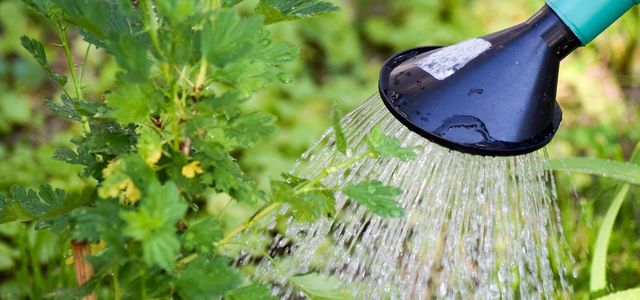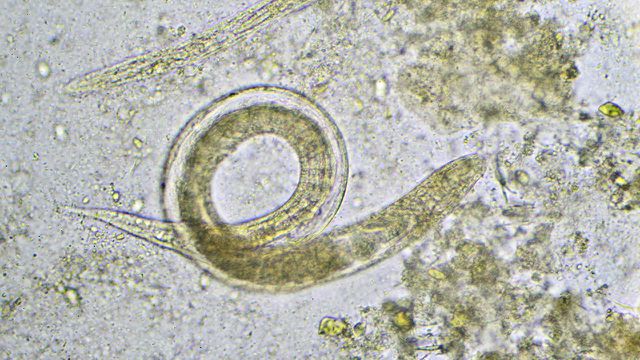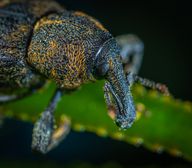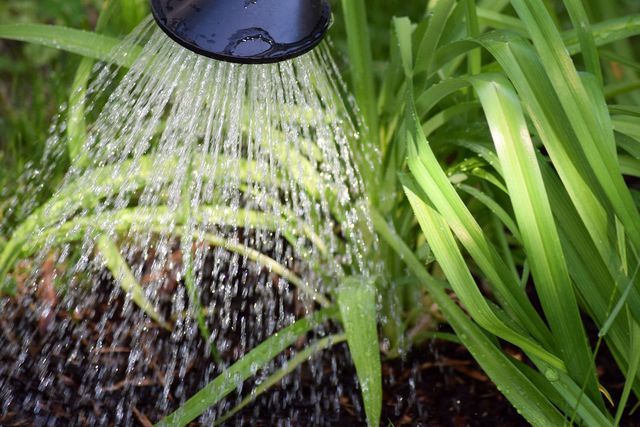
Nematodes are hardly visible to the naked eye. Nevertheless, the nematodes can have great benefits for hobby gardeners. We show you what exactly nematodes are and how you can use them.
Nematodes are tiny little nematodes that, depending on the species, can be useful but also harmful to your garden. They play an important role in the formation of humus, among other things. However, the worms are most commonly used in natural pest control. In this article you will learn what nematodes are, what types there are and how you can use the nematodes as beneficial insects in your garden.
Contents
What are nematodes?

Nematodes are not without reason also known as threadworms. The little animals are usually only a few millimeters in size and are therefore difficult to recognize. The small worms move with the help of longitudinal muscles that run from their head to their tail.
Depending on the species, nematodes feed on bacteria, algae, fungi or predatorily preyed larvae such as grubs, among other things. With the appendages on their mouths, the worms pick up their food and also scan their surroundings.
Nematodes: pests or beneficial organisms?
Whether nematodes are beneficial or dangerous to your garden depends primarily on their species. As one of the most species-rich groups, the nematode family includes both herbivorous and predatory species. Predatory nematodes of the genus Heterorhabditis, in particular, are finding increasing use as beneficial insects. Nematodes of this genus bring two basic benefits to your garden:
Humus formation: As so-called decay dwellers, nematodes help form new humus soil and compost organic materials.
Pest control: You can use nematodes to effectively control a variety of pests, such as the pine weevil. The nematodes feed on the larvae of the beetles living in the soil, preventing them from reproducing further.

However, some nematode species, such as beet cyst nematodes, can be dangerous to your plants. These herbivorous nematodes penetrate the root system of the plant, where they disrupt its metabolism. Potatoes, beets, spinach and canola are particularly at risk from these nematodes. The animals penetrate the plant tissue with their mouth sting and damage it with their saliva.
To prevent your plants from being attacked by free-living nematodes, you can resort to the following preventive measures:
Improve plant living conditions: To make your garden less susceptible to harmful nematodes, you should regularly provide your plants with organic fertilizer and improve the soil climate. For example, by putting algal lime under the soil. This will strengthen your plants and make them more resistant to pests and diseases.
Resistant plants: In well-stocked garden stores, you can increasingly find cultivated tomato and potato varieties that are resistant to a variety of nematodes. These include, for example, the tomato variety ‘Dolcevita’ and the potato variety ‘Alexandra’.
Control pests: with the right kind of nematodes

If you attach great importance to natural plant protection, nematodes are ideal for controlling pests in your garden. If you use the nematodes correctly, there will be no harm to humans, animals or plants. When buying nematodes, however, you should make sure that you buy the right kind.
You can find out which pests you can control with which nematode species here:
Largemouth weevil: The larvae of the largemouth weevil are best controlled with nematodes of the species ‘Heterorhabditis’. You can often find these nematodes in online or garden stores under the name HM nematodes. These nematodes require a soil temperature of at least 12 degrees Celsius to survive. For cooler temperatures of five to 12 degrees Celsius, you can use so-called SK nematodes of the genus ‘Steinernema kraussei’.
Fungus gnats: The larvae of the fungus gnat pose a particular threat to houseplants. SF nematodes of the genus ‘Steinernema feltiae’ can be used all year round at room temperature and outdoors from 12 degrees Celsius to control the pest.
Grubs: Grubs are, for example, the larvae of the garden leaf beetle. To get rid of these grubs, it is also best to use HM nematodes. Bring the nematodes best from August to September in the soil.
Slugs: Even slugs can be controlled biologically with nematodes. It is best to use nematodes of the genus ‘Phasmarhabditis hermaphrodita’, PH nematodes for short. These nematodes work at temperatures as low as five degrees Celsius. However, they multiply best at temperatures between ten and 25 degrees.
You can buy nematodes relatively easily today at garden supply stores or online. The worms usually arrive in powder form. In this form you can store them for some time in the refrigerator. It is best to pay attention to the best-before date. One package of HM nematodes is usually enough for about 12 square meters of area. Once dissolved in water, you must use the worms as soon as possible.
How to expel nematodes
To apply nematodes correctly, proceed as follows:
Water the soil generously at the application site. Nematodes work best in moist soil.
- Now dissolve the nematode powder in a bucket or watering can with rainwater. Follow the product information for the amount of water.
- Now water your plants with the nematode-water mixture. Make sure that the nematodes can settle at the bottom of the watering can after a while. Shake the can gently from time to time to prevent this.
- Be sure to lightly water the soil again right after you have applied the nematodes.
- Keep the soil evenly moist for the next two to three weeks. However, you should avoid waterlogging at all costs!
- After about three weeks the nematodes should have finished their work. Now check whether the animals have really eliminated all pests. In the case of grubs and other larvae, for example, you can scan the soil. The killed larvae should have a brown-reddish color. For fungus gnats, you can use yellow boards to check if the pests are gone.
- Tip: It is best to apply the nematodes in overcast weather or in the evening. This is because the moisture-loving nematodes dry out quickly in excessively hot temperatures and strong UV light.









